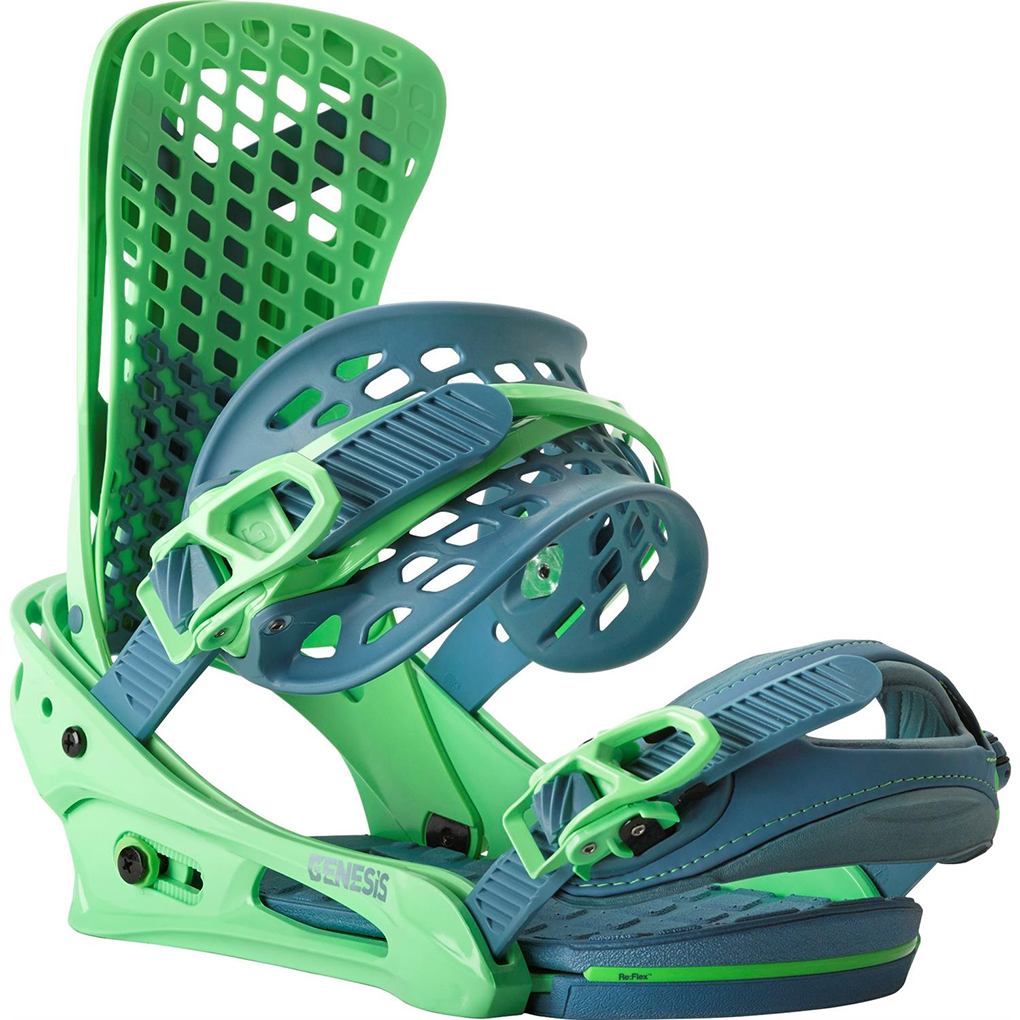
Burton Genesis Re:Flex Binding
Size Tested: Medium
Features:
Single-Component 30% Short-Glass/Nylon Composite Re:Flex Baseplate
Kickback Hammock
Double Take Buckles
Hammockstrap heel strap
Ultralight Gettagrip Capstrap
Paired with: Burton Antler 157.5, K2 Panoramic Split 162
Boot: K2 Ender, Size 10
Days ridden: 40+
Locations: Taos Ski Valley, Snowbird, Copper Mountain, Winter Park, Mary Jane, Indian Peaks Backcountry
The Genesis binding looks like it belongs on a spaceship, not a snowboard. It’s made completely of plastic and foam, and employs some unique, very interesting design features that were intended to create “the most comfortable binding ever.”
More specifically, Burton says the Genesis “combines anatomical elements that smooth and cushion the overall [riding] experience with the latest breakthroughs in hi-back and strap design to wrap and cradle your boots in complete suspension.”
With over 40 days in the binding, I think Burton has accomplished what they hoped to with the Genesis. It is certainly the most comfortable binding I’ve ever ridden.
Design
First, I’ll go over the two most notable components of the Genesis, its hi-back and straps. Burton calls the Genesis’ hi-back the “Kickback Hammock.” It cushions contact between the boot and the stiff, nylon hi-back by placing a soft, mesh-like hammock with a rubber patch on the heel in front of the main frame of the hi-back. A hard plastic “spring” sits in between the hammock and the frame, ensuring that there is still proper energy transfer between them. These three components of the Genesis’ hi-back are supposed to yield a dampened, more comfortable feel when rolling the boot from side to side from one turn to the next.
The second important design feature of the Genesis are Burton’s Double Take Buckles, which are said to enable “immediate engagement, faster uptake…fewer cranks to tightness” and a more secure hold. The binding’s ladder straps are two-sided, and the grooves/ridges on the outside of the strap run in a diagonal “helical” pattern. The buckle’s retention teeth grasp the ladder from both sides (more quickly than a standard design according to Burton) and the helical teeth allow the buckle to take in slack from the strap faster, too.
While the basic design of the Genesis’ straps is notable, they’re also lightweight. The binding’s “Hammockstrap” heel strap is made of molded plastic, and is completely stitch free (less stitching material = less weight), while the toe strap is made mostly of EVA foam.
So how does all this engineering translate to on-snow performance?
Performance: Buckles & Straps
Strapping in on Snowbird’s Hidden Peak for the first time, I was instantly impressed by Burton’s new buckle technology. The helical buckles and ladders definitely feel smoother to engage and crank down than those on a standard binding (e.g., the the Ride Capo or K2 Company), and allowed for virtually no slipping/loosening, even in very cold temps around -15 degrees F.
The straps themselves also turned out to be excellent. Initially I was concerned about pinch points that might come from the plastic heel strap, as I wasn’t sure it would provide the same amount of flex-and-give that a leather and gel strap can. But the mesh plastic design of the strap is incredibly comfortable. Additionally the minimal material used in the heel strap makes for comfortable, unhindered ankle flexion that heavily padded heel straps cannot provide.

The Genesis’ toe strap did its job well too, but the EVA foam used in its construction (which was fairly flimsy to begin with) softened significantly as the season went on. As the material softened, the strap stretched (which happens in all toe straps, but not to the same extent) and I had to adjust the strap a few times during the season. I think Burton should consider picking a different spot to save weight and stick to using rubber and/or leather on the Genesis’ toe strap.
The Ride
As I made my first turns with the Genesis bindings mounted on the Burton Antler 157.5, the Kickback hi-back definitely felt a little different than the one-piece hi-back on a standard binding.
The Genesis’ hi-back “hammock” provides a very comfortable feel, especially through lateral boot movement and grab tweaks. However, while the binding is certainly comfortable when you’re strapped into it, the initial responsiveness of the Genesis’ highback is a bit “squishy” or delayed.
Having started with the hi-back in an upright position, I added 4 clicks of forward lean after the first run (2 more clicks than I usually need) before the binding would allow the amount of heelside bite that I prefer. To be clear, while the hammock does give the Genesis’ hi-back an initially soft (and very comfortable) feel, on the whole, it doesn’t perform like a soft binding on edge on either hardpack and choppy snow on a lighter board like the Antler. It’s not a stiff binding—I’d say Burton’s 6/10 rating is pretty accurate—but it was certainly supportive enough for all-mountain freestyle riding.
Once engaged in a turn, the Genesis provides nice, supportive edge hold, and I never felt as if the hi-back was folding or giving out through a heel side turn on the Antler. The Genesis doesn’t seem to provide enough initial stiffness and response to adequately control heavier, more demanding boards, however, which I’ll get to in a moment.
